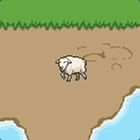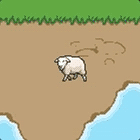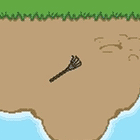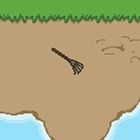Entity Types
In the MGE, there are three types of entities. Each has a PrimaryIdType (determined by the type of tile being placed):
For the first two types (tile and animation), the tile will rotate when the entity changes which direction it is "facing," whereas the last type (character) will instead choose the correct animation among those it was assigned (north, south, east, or west). Therefore entities that are meant to have standard character animations (like the sheep below) or that need to retain their appearance when moving around the map (like the rake below) must be the third type.
| Rotating Tiles | Assigned Animations |
|---|---|
| sheep (animation) | sheep (character) |
 |  |
| rake (tile) | rake (character) |
 |  |
In addition, there is currently no way to control animations with scripts unless the entity is a character entity. (See the the modem and bookcase in Chapter 1 of the Black Mage Game.)
Tile Entity
If you place a static (unanimated) tile from a tileset onto an object layer in a Tiled map, it will become a tile entity.
NOTE
If the tile's Class property is defined within entity_types.json, it will instead become a character entity.
PrimaryIdType:0(tileset)PrimaryId: theidof the tileset the entity is usingSecondaryId: theidof the tile on the tileset (the Nth tile, counting left to right and top to down, 0-indexed)
These are a simple way of making props interactable.
If you don't want an interactable prop to be be Y-indexed with other entities when drawn, you could instead put the prop in the map geometry itself and create a null entity for the interactable aspects.
Null Entity
A null entity is a tile entity whose tile is entirely transparent. They're useful for implementing scripting behaviors not directly supported by the MGE, such as having an entity procedurally chase a moving (invisible) target.
A common use is to enable interaction behavior for things that aren't themselves entities. To do this, place a null entity on the map wherever you want interaction behavior to happen, then use the null entity's on_interact script slot for the interaction behavior.
Disadvantages: The null entity can be hacked into another tile (presumably one with pixel data), in which case a new object will seemingly appear out of nowhere.
You cannot click on transparent pixels in Tiled. To select a null entity, you'll need to use the Layers pallet. To move one, change its X and Y values in the properties pane once you've selected it.
Animation Entity
If you place a animated tile from a tileset onto an object layer in a Tiled map, it will become an animation entity.
NOTE
If the tile's Class property is defined within entity_types.json, it will instead become a character entity.
PrimaryIdType:1(animation)PrimaryId: theidof the animation the entity is playingSecondaryId: does nothing
When the game is encoded, all animations are shoved together into a single list, so the id for PrimaryId is regularly subject to change. Therefore, you will never want to use the PrimaryId to choose a specific animation.
Animation entities are most useful for animated props, e.g. a water fountain, a torch flickering on a wall, a birthday cake with a moving candle flame. Such entities need not use any of the entity properties available to them, though they could.
While NPCs will likely need to be character entities, simpler ones might work perfectly well as animation entities, e.g. WOPR in the Black Mage Game.
Character Entity
If you place a tile onto an object layer, and the Class (formerly Type) property of the tile has been defined in entity_types.json, it will become an character entity.
PrimaryIdType:2(entity_type)PrimaryId: theidof the entity withinentity_types.jsonSecondaryId: does nothing
You need not manipulate PrimaryId to alter the appearance of a character entity. Instead, you can use actions that change the entity_type value to one of the ones defined within entity_types.json.
What's special about character entities is that they can have a number of animations assigned to them and they will switch animations automatically depending on context (walking or not, facing north/south/east/west, etc.), as well as having other attributes, like a default portrait image. NPCs will therefore likely be this type.
In the MGE, character entities will default to their idle animation regardless of the tile that was placed Tiled. (I.e. if you use a "walking animation" tile for the entity on the Tiled map, the entity will appear to be walking in Tiled, but not within the MGE.)
Character entities will face the north by default, but if the tile placed has been assigned to a NSEW direction and a purpose, the entity will instead face the direction associated with that tile's assignment.